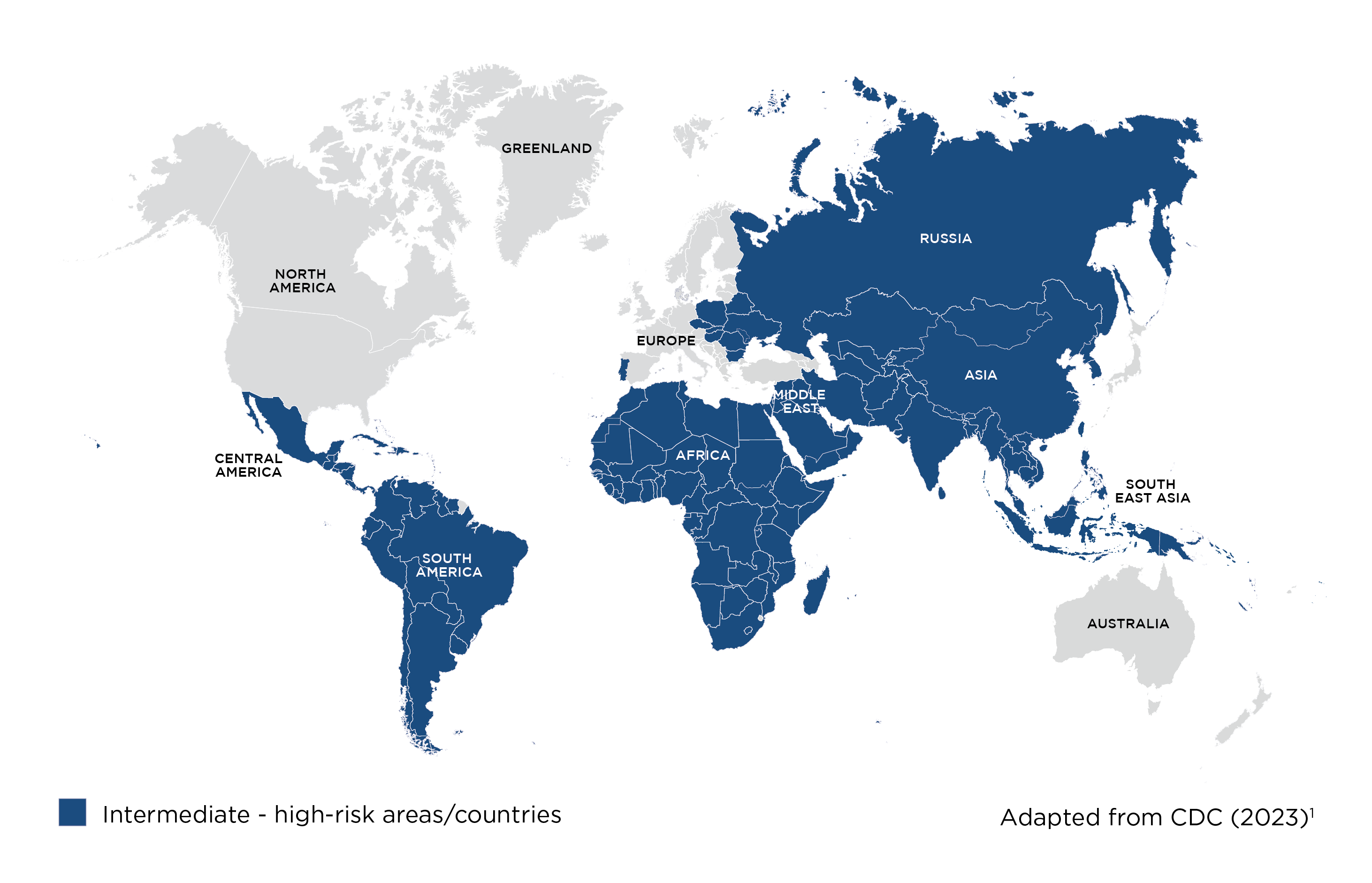More than 20% of travellers visiting high risk areas get travellers’ diarrhoea, which can significantly disrupt their travel plans.3,5
Risk areas for Travellers’ Diarrhoea

FAQs
-
Key fact
-
How do you get travellers’ diarrhoea?
Mostly from ingesting food or water that has been contaminated with the viruses, bacteria or protozoa which cause the disease.2,3
-
Which countries are affected by travellers’ diarrhoea?
Travellers’ diarrhoea can occur in many areas of the world but is the most common in Asia, the Middle East, Africa, Mexico, and South and Central America. (see map).1
-
What are the symptoms of travellers’ diarrhoea?
Travellers’ diarrhoea is defined as three or more unformed stools in a 24 hour period with at least one additional symptom.4 Symptoms can start from as little as 6 hours and will depend on the type of bug that has caused the infection. They may include watery or bloody diarrhoea, abdominal pain, fever, and vomiting.2
-
How serious is travellers’ diarrhoea?
Without treatment, travellers’ diarrhoea usually lasts three to seven days.2 Medical care should be sought if symptoms do not clear up within three days or immediately in the case of fever, blood and/or mucus in stools, altered mental state, severe stomach pain, jaundice or rash.5 Early medical care is also recommended for children, the elderly or vulnerable people cannot tolerate fluids or are dehydrated.5
-
Can I prevent getting travellers’ diarrhoea?
You can take the following precautions to help reduce your risk of infection:
- Visit your nearest convenient pharmacy or specialist travel health clinic for a risk assessment before your trip
- Wash your hands frequently, especially before preparing or eating food, and after using the toilet5
- Ensure good hygiene is practiced when swimming. Don’t swim if you have diarrhoea, and avoid ingesting any pool water5
- Use boiled, bottled or disinfected water for drinking, preparing food and drinks, as well as brushing your teeth6
- Avoid ice in drinks6
- Avoid eating raw or undercooked meat, fruit and vegetables that you haven’t prepared yourself. It is also advised to avoid eating shellfish and seafood6
Ready to get started? Check now for your nearest travel health clinic.
Get friendly advice from the UK's largest network of travel clinics*.
* This list is not exhaustive and other travel health providers are available.
References
- Centers for Disease Control and Prevention. Yellow Book 2024. Chapter 4 Travel-Associated Infections & Diseases. Escherichia coli, Diarrheagenic. May 2023. Available online: https://wwwnc.cdc.gov/travel/yellowbook/2024/infections-diseases/escherichia-coli-diarrheagenic (Last accessed May 2023)
- Centers for Disease Control and Prevention. Yellow Book 2024. Section 2 Preparing International Travelers. Travelers’ Diarrhea. May 2023. Available online: https://wwwnc.cdc.gov/travel/yellowbook/2024/preparing/travelers-diarrhea (Last accessed May 2023)
- Ericsson CD. Travelers’ diarrhea. Epidemiology, prevention, and self treatment. Infect Dis Clin North Am 1998;12:285–303
- Steffen R. Epidemiology of travellers’ diarrhea. J Travel Med 2017;24:S2-S5.
- Factsheets. Travellers’ Diarhhoea. August 2019. Available online: https://travelhealthpro.org.uk/factsheet/53/travellers-diarrhoea (Last accessed May 2023)
- Centers for Disease Control and Prevention. Yellow Book 2024. Section 2 Preparing International Travelers. Food & Water Precautions. May 2023. Available online: https://wwwnc.cdc.gov/travel/yellowbook/2024/preparing/food-and-water-precautions (Last accessed May 2023)
UK-BOTB-2100034 (v2.0) May 2023
